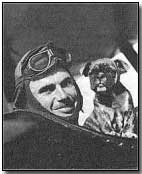Who's Who - Field Kindley
 Field Kindley (1896-1920)
was a leading U.S. air ace during World War One, registering twelve 'kills'
between June-November 1918.
Field Kindley (1896-1920)
was a leading U.S. air ace during World War One, registering twelve 'kills'
between June-November 1918.
Kindley was perhaps an admirable example of the breed of air ace who demonstrated remarkable fighting skills - hence his twelve successes - while proving rather less adept in the actual piloting of his aircraft. In short Kindley was somewhat accident prone and may even be able to lay claim to downing more Allied aircraft than German opponents.
Born on a farm near Pea Ridge, Arkansas on 13 March 1896 Kindley was largely raised by a grandmother and two aunts in Bentonville (his mother having died and his father now working in the Philippines). Following high school graduation Kindley worked briefly as a travelling salesman and as part owner and manager of a movie theatre in Coffeyville, Kansas.
The formal U.S. declaration of war with Germany however resolved Kindley to enlist with the Kansas National Guard in May 1917, determined to ultimately see action on the battlefields of France and Flanders. He rapidly determined however that life as an infantryman ill-suited his talents and switched to service with the Army Signal Corps, attending the School of Military Aeronautics at Illinois University prior to his despatch to Britain.
Trained with the air service in Oxford, England Kindley found his flight instructors less than impressed with his aeronautical abilities; the harsh criticism may have been justified, Kindley inflicting repeated damage to his aircraft during landings (collapsing the undercarriage on one occasion). Within the space of a single week seven of Kindley's ten training aircraft suffered mechanical failures, accidental or otherwise.
Thereafter assigned to fly aircraft across the English Channel to France Kindley continued his run of ill-luck. Aside from periodically getting lost - landing at the wrong aerodrome - on one occasion he flew his aircraft into the face of a cliff at Dover, an act which necessitated a brief spell of hospitalisation followed by recuperation; inevitably the aircraft was totally destroyed.
Nevertheless by May 1918 Kindley found himself transferred to France for front-line missions with the Royal Air Force's 65th Squadron. The move proved inspired. The following month he achieved his first air victory, downing a German Pfalz aircraft flown by the commander of Jasta 5, Wilhelm Lehmann. In early July he was transferred to the new 148th U.S. Aero Squadron, soon afterwards downing a German Albatross D3 aircraft over Ypres, achieving the first air success by an exclusively-American unit.
Kindley subsequently became the squadron's commander when its incumbent fell ill; shortly afterwards, on 2 September 1918, he achieved his fifth air victory during a mass dogfight between 12 Allied Sopwith Camels and 20 German Fokker D7s, a success which qualified him as an ace. During the encounter Kindley's aircraft suffered significant (and consequently fatal) machine gun damage; he was also alarmed to find his goggles shot away by a German airman.
Kindley's reputation today however chiefly rests upon an action fought on 27 September 1918. Kindley's squadron was involved in a routine bombing raid behind German lines, during which the unit attacked a group of transports near Marcoing. Having failed to down a German observation balloon, the unit continued to seek bombing targets. Kindley, having located a single German machine gun nest, honed in and succeeded in destroying it.
Not content with this combined success Kindley spied a second disguised machine gun nest and prepared to similarly launch an attack. Before he could do so however he came under fire by a German Halberstadt two-seater aircraft; this he eventually succeeded in downing, after which he expended the remainder of his available ammunition upon retreating German infantry.
Finally turning for home Kindley observed a single Allied aircraft being pursued by two enemy aircraft; despite having no ammunition of his own he nevertheless joined the fray and succeeded in frightening off the attacking aircraft.
For his remarkable actions that day Kindley was deservedly awarded both the Distinguished Service Cross and the Distinguished Flying Cross (the latter a British citation).
Remaining with the service after the armistice and promoted Captain in late February 1919, Kindley finally lost his life while on a flight training exercise with 94th Aero Squadron on 1 February 1920; a control cable snapped on his aircraft causing it to nose-dive into the ground. Kindley was killed on impact. He was a month short of his 24th birthday.
'Push' was slang signifying a large-scale attack upon enemy positions.
- Did you know?
